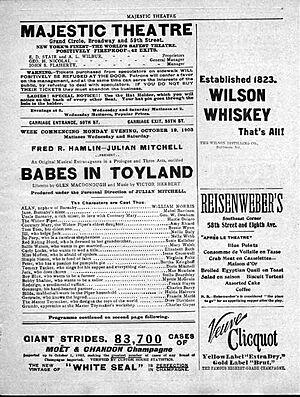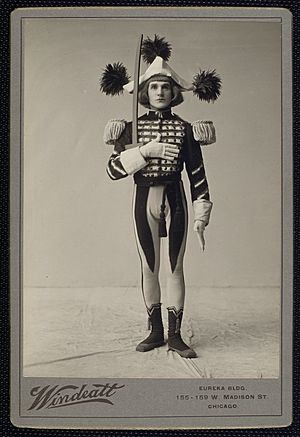Babes in Toyland (operetta) facts for kids
Quick facts for kids Babes in Toyland |
|
|---|---|

Sheet music cover
|
|
| Music | Victor Herbert |
| Lyrics | Glen MacDonough |
| Book | Glen MacDonough |
| Productions | |
Babes in Toyland is a classic operetta. An operetta is like a light opera with spoken parts and catchy songs. This famous show was created by Victor Herbert, who wrote the music, and Glen MacDonough, who wrote the story and lyrics. It brings together many well-known characters from Mother Goose nursery rhymes. The story is a fun, musical adventure, perfect for the Christmas season.
After the huge success of their musical The Wizard of Oz, producer Fred R. Hamlin and director Julian Mitchell wanted to make more family-friendly shows. They asked Victor Herbert to join them. Babes in Toyland became famous for its songs like "Toyland", "March of the Toys", and "I Can't Do the Sum". The main song "Toyland" and the instrumental "March of the Toys" are still very popular, especially around Christmas time.
The first show opened in Chicago in June 1903. It then toured to other cities before coming to New York in October 1903. It was very popular and ran for 192 performances. This success led to many more "fairy-tale" musicals in the years that followed.
Contents
What is Babes in Toyland About?
Babes in Toyland tells the story of two orphans named Alan and Jane. Their evil Uncle Barnaby wants to steal their money. He tries to get rid of them by sending them into the dangerous Spider Forest.
The children escape and find their way to Toyland. This magical place is filled with characters from nursery rhymes. You'll see Little Bo-Peep and Tom Tom, among others. In Toyland, they meet the kind Master Toymaker. He helps them, and together they try to stop Uncle Barnaby and save the day. The story is full of adventure, catchy songs, and a bit of holiday magic.
Major Shows of Babes in Toyland
The very first New York show opened on October 13, 1903. It was at the Majestic Theatre. People loved the amazing scenery and costumes. These made Toyland come alive. There were grand places like the "Floral Palace of the Moth Queen" and the "Garden of Contrary Mary."
The show was so popular that two touring groups traveled across the country in 1904. One tour kept the big sets and many of the original actors. The other was a smaller show for shorter visits to towns.
Babes in Toyland has been performed many times over the years.
- It was staged nine times at The Muny, an outdoor theater, starting in 1920.
- It returned to Broadway in 1929 and again in 1930.
- In 1975, a new version was written for the Light Opera of Manhattan (LOOM). This version became a popular Christmas show for many years. It even invited children from the audience to help "wind up" the toy dancers. This happened during the "March of the Toys."
In 2003, for the operetta's 100th anniversary, a puppet show version called "Toyland!" was created. It featured the voices of famous actors Mickey Rooney and his wife Jan Rooney. This puppet show has toured every year since.
Main Characters You'll Meet
Here are some of the key characters you'll meet in Babes in Toyland:
- Alan and Jane: These are the young orphans and the heroes of the story.
- Uncle Barnaby: He is the greedy villain who wants to harm Alan and Jane.
- The Widow Piper: A kind woman with many children. These include Tom Tom and Contrary Mary.
- Tom Tom: He is the Widow Piper's eldest son.
- Contrary Mary: She is the Widow Piper's eldest daughter. She is known for being a bit stubborn.
- Little Bo-Peep: A shepherdess who has lost her sheep.
- The Master Toymaker: He is the wise and kind creator of all the toys in Toyland.
- Grumio: The Master Toymaker's apprentice.
- Gonzorgo and Roderigo: These are Uncle Barnaby's hired helpers. They are not very smart.
- Nursery Rhyme Friends: You'll also see characters like Jack and Jill, Little Miss Muffet, Simple Simon, and more!
Famous Songs and Music
The music in Babes in Toyland is one of its most loved parts. Here are some of the musical numbers:
Songs from Act 1
- "Don't Cry, Bo-Peep" – A comforting song for Little Bo-Peep.
- "I Can't Do the Sum" – A charming song sung by Jane.
- "Go to Sleep, Slumber Deep" – A gentle lullaby.
Songs from Act 2
- "March of the Toys" – This is one of the most famous instrumental pieces. It is often played during Christmas. It features the toy soldiers marching.
- "Toyland" – This is the beloved theme song of the operetta. It is sung about the magical world of toys.
Songs from Act 3
- "An Old-Fashioned Rose" – A sweet song.
Recordings and Film Versions
Many recordings of Babes in Toyland music have been made over the years. The original Victor Herbert Orchestra recorded some selections in 1911–1912. Later, in 1944, Decca Records released a popular album of songs from the show.
Babes in Toyland has also been adapted into several films and television shows:
Movies
- 1934 Film: Laurel and Hardy starred in a film version. It was called Babes in Toyland (also known as March of the Wooden Soldiers). This movie used some of Herbert's songs. However, it had a very different story.
- 1961 Disney Film: Walt Disney made a colorful Technicolor film version. It starred Ray Bolger, Annette Funicello, and Ed Wynn. This movie also changed the plot quite a bit. But it kept much of the original music.
- 1997 Animated Film: An animated movie version was released by Metro-Goldwyn-Mayer. It had a new story and only one of the original songs.
Television Shows
Several TV versions of Babes in Toyland have been broadcast. They are especially popular around Christmas.
- A 1960 TV adaptation was part of The Shirley Temple Show. It starred Shirley Temple and Jonathan Winters. This version kept more of the original operetta's main plot.
- A 1986 TV movie featured Drew Barrymore and Keanu Reeves. It had a new plot and mostly new songs.
Children's Book
A children's book based on the operetta was published in 1904. It was written by Glen MacDonough and Anna Alice Chapin. It had lovely illustrations by Ethel Franklin Betts.



